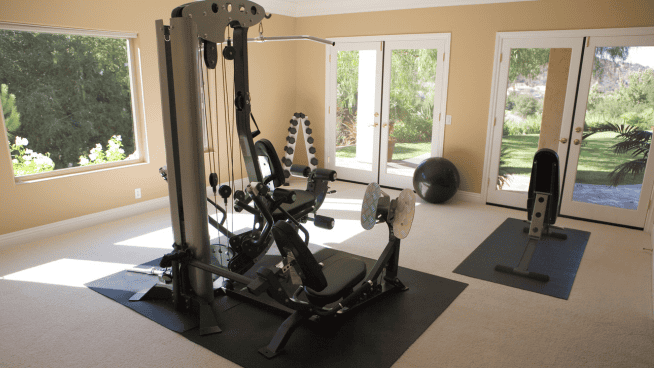Secrets to Building Speed and Agility
It is time to bring to light what is really behind developing speed, and it doesn’t start with any miracle drill or band attached to you while you run.
Simple Truths In Developing Speed and Agility
- Quality is of utmost importance
- Increase the ability to apply force into the ground and absorb it
- Improve stride length and frequency
- Increase ability to endure workouts
Movements That Improve Speed Development
- Sprinting
- Resisted sprinting
- Plyometric Jumps
- Olympic Lifting
- Heavy Squats/Deadlifts
Five Speed Questions
Q1: Well if we aren’t doing “speed and agility” drills, how are the athletes getting faster?
A: Speed and agility isn’t a bunch of cone drills that look cool with minimal rest. They are ignoring the truth and science of how the body components work, and how speed is actually developed. Speed and agility drills don’t require intense sprinting and running with minimal recovery. These equate to conditioning. What they are; drills that have specific work to rest times and Maximal effort. Designed to work on one or two elements at a time. Such as lateral (side to side) speed shuffling and linear (straight ahead) sprinting. For speed and agility, we do need to work plane sessions out and hit all the variables of moving in various planes of motion, direction, and sprinting.
Q2: What is the best drill or exercise for improving speed?
A: The ultimate thing to getting faster is to sprint. Realize that to improve your top-end speed, these sprints can not be done at anything less than 100 percent. The next thing is to get stronger, build a bigger engine, and build in better breaks.
Q3: My athlete is fast but can’t change direction. What do we need to do?
A: If you have ever watched “Mighty Ducks” there is one hockey player who is super fast but can’t stop. He isn’t effective because he has no control. We have to be able to stop to be an effective player and to reduce injury.
These type of athletes need to focus on 3 things
- Coordination of their body- practicing changing hip levels and footwork.
- Build-in better brakes- continue to get stronger and do movements with eccentrics.
- Train in other planes and directions besides straight ahead linear speed.
Q4: Why don’t we just have all athletes run track?
A: I think Track and Field is a great sport to be involved in. I do believe it can help with speed development. However, it is limited. It covers much of the linear speed development if they are running sprints and some power development if they are a thrower or jumper but many sports have multiple other components that need to be addressed to fully develop speed and agility in all aspects.
Q5: My athlete is fast in drills and practices but not in the game. What’s the deal?
A: The truth is that not everything can be solved by practicing drills and getting stronger. You need to practice and study the game. Know the Game inside and out. If you know where to be and place yourself correctly on the field you, will be faster than anyone else. The better your knowledge of the game, the more things will happen and you will be in the right place at the right time. Your brain can be the best thing to help you improve your speed.
Putting Together a Program and Applying it to your Athletes
Many people hear my answers to the previous questions and then ask one final question. They say, “That all sounds great, but how do you guys program speed and apply it?” Well this is what we do.
We break the components into the following sections
- Form Work and Running Mechanics
- Keep these early in the workout as they are technique intensive.
- Warmup basics- A March, A Skip, B march, B Skip, Arm Drill
We do these drills typically as part of our general warm-up and to improve coordination and practice for the feel of the correct movement.
Coaching Techniques
There are small nuances of sprint and change of direction techniques that will help. Certain angles, arm actions, and mechanics do make a difference.
Linear Speed
- Typical distances we do for Sprints – 10, 20, 40, 60 & 100 yards
- Short – 10s and 20s to work on acceleration
- Medium – 40s and 60s to hit a top speed
- Long – 100s to work on maintaining top speed/endurance
Typically 40 to 60 yards is when you hit your fastest speed and then you try to maintain it after that.
Chasing Sprints
Sled Push to Sprint
Sprint Starts- Tall Kneeling
Lateral Speed & Change of Direction
Shuffling. Various steps-Crossover and open step. Accelerate, deceleration, and changing the level of your hips and direction of running. Mainly we put lateral speed and change of direction together to provide efficiency and how well they complement one another.
5/10/5
Lateral Shuffle to Open Step Sprint
Reaction
Putting all the other components together we add another element to it. We use a lot of tennis ball drops for this and change the start position. I say right is an odd number and left is even. I then go from 1-10 in numbers. To increase the difficulty we increase the number from 1-100. 56 is hard because you have to process two numbers with one being odd and the second being even and process that 56 is an even number after that. To continue that, the cones on either side are colored and I could say a color or a number. Thus we continue to improve how quickly they can react and process information to only be concerned with what information is useful.
Tennis Ball Drops
[youtube video=“t2ZkpdMulti-Object Reactive Drill
Creating power is what creates a better first step. The stronger and more powerful an athlete becomes, the faster and more explosive they will be. Simple. The best way to be effective is consistency and time. Time will build the proper foundation. What does that look like? There are many ways to apply it and put it together, but here is a way we like to do it:
- 5 Final Closing Principles
- Try to keep it simple
- Sprint and run in all directions
- Add volume as conditioning and skill of movements improve
- Get stronger every day
- Repeat daily
RECOMMENDED FOR YOU
MOST POPULAR
Secrets to Building Speed and Agility
It is time to bring to light what is really behind developing speed, and it doesn’t start with any miracle drill or band attached to you while you run.
Simple Truths In Developing Speed and Agility
- Quality is of utmost importance
- Increase the ability to apply force into the ground and absorb it
- Improve stride length and frequency
- Increase ability to endure workouts
Movements That Improve Speed Development
- Sprinting
- Resisted sprinting
- Plyometric Jumps
- Olympic Lifting
- Heavy Squats/Deadlifts
Five Speed Questions
Q1: Well if we aren’t doing “speed and agility” drills, how are the athletes getting faster?
A: Speed and agility isn’t a bunch of cone drills that look cool with minimal rest. They are ignoring the truth and science of how the body components work, and how speed is actually developed. Speed and agility drills don’t require intense sprinting and running with minimal recovery. These equate to conditioning. What they are; drills that have specific work to rest times and Maximal effort. Designed to work on one or two elements at a time. Such as lateral (side to side) speed shuffling and linear (straight ahead) sprinting. For speed and agility, we do need to work plane sessions out and hit all the variables of moving in various planes of motion, direction, and sprinting.
Q2: What is the best drill or exercise for improving speed?
A: The ultimate thing to getting faster is to sprint. Realize that to improve your top-end speed, these sprints can not be done at anything less than 100 percent. The next thing is to get stronger, build a bigger engine, and build in better breaks.
Q3: My athlete is fast but can’t change direction. What do we need to do?
A: If you have ever watched “Mighty Ducks” there is one hockey player who is super fast but can’t stop. He isn’t effective because he has no control. We have to be able to stop to be an effective player and to reduce injury.
These type of athletes need to focus on 3 things
- Coordination of their body- practicing changing hip levels and footwork.
- Build-in better brakes- continue to get stronger and do movements with eccentrics.
- Train in other planes and directions besides straight ahead linear speed.
Q4: Why don’t we just have all athletes run track?
A: I think Track and Field is a great sport to be involved in. I do believe it can help with speed development. However, it is limited. It covers much of the linear speed development if they are running sprints and some power development if they are a thrower or jumper but many sports have multiple other components that need to be addressed to fully develop speed and agility in all aspects.
Q5: My athlete is fast in drills and practices but not in the game. What’s the deal?
A: The truth is that not everything can be solved by practicing drills and getting stronger. You need to practice and study the game. Know the Game inside and out. If you know where to be and place yourself correctly on the field you, will be faster than anyone else. The better your knowledge of the game, the more things will happen and you will be in the right place at the right time. Your brain can be the best thing to help you improve your speed.
Putting Together a Program and Applying it to your Athletes
Many people hear my answers to the previous questions and then ask one final question. They say, “That all sounds great, but how do you guys program speed and apply it?” Well this is what we do.
We break the components into the following sections
- Form Work and Running Mechanics
- Keep these early in the workout as they are technique intensive.
- Warmup basics- A March, A Skip, B march, B Skip, Arm Drill
We do these drills typically as part of our general warm-up and to improve coordination and practice for the feel of the correct movement.
Coaching Techniques
There are small nuances of sprint and change of direction techniques that will help. Certain angles, arm actions, and mechanics do make a difference.
Linear Speed
- Typical distances we do for Sprints – 10, 20, 40, 60 & 100 yards
- Short – 10s and 20s to work on acceleration
- Medium – 40s and 60s to hit a top speed
- Long – 100s to work on maintaining top speed/endurance
Typically 40 to 60 yards is when you hit your fastest speed and then you try to maintain it after that.
Chasing Sprints
Sled Push to Sprint
Sprint Starts- Tall Kneeling
Lateral Speed & Change of Direction
Shuffling. Various steps-Crossover and open step. Accelerate, deceleration, and changing the level of your hips and direction of running. Mainly we put lateral speed and change of direction together to provide efficiency and how well they complement one another.
5/10/5
Lateral Shuffle to Open Step Sprint
Reaction
Putting all the other components together we add another element to it. We use a lot of tennis ball drops for this and change the start position. I say right is an odd number and left is even. I then go from 1-10 in numbers. To increase the difficulty we increase the number from 1-100. 56 is hard because you have to process two numbers with one being odd and the second being even and process that 56 is an even number after that. To continue that, the cones on either side are colored and I could say a color or a number. Thus we continue to improve how quickly they can react and process information to only be concerned with what information is useful.
Tennis Ball Drops
[youtube video=“t2ZkpdMulti-Object Reactive Drill
Creating power is what creates a better first step. The stronger and more powerful an athlete becomes, the faster and more explosive they will be. Simple. The best way to be effective is consistency and time. Time will build the proper foundation. What does that look like? There are many ways to apply it and put it together, but here is a way we like to do it:
- 5 Final Closing Principles
- Try to keep it simple
- Sprint and run in all directions
- Add volume as conditioning and skill of movements improve
- Get stronger every day
- Repeat daily










